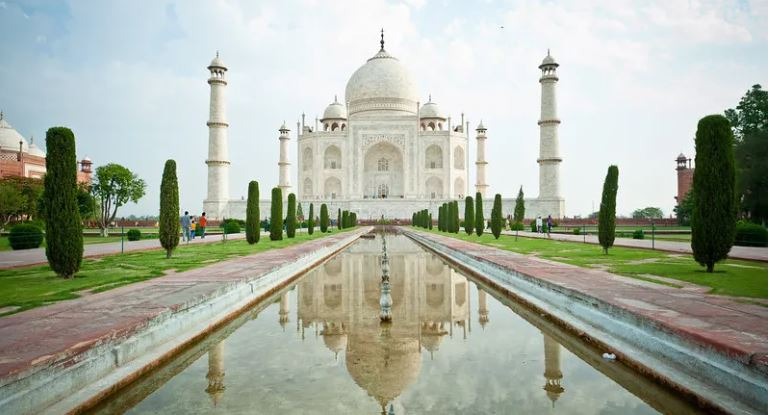Do You Know How the Taj Mahal Was Built Without Modern Tools
#TajMahal, #MughalArchitecture, #ShahJahan, #IndianHeritage, #WorldWonder, #TajWithoutMachines, #HistoryOfIndia, #AncientEngineering, #MarbleMonument, #UNESCOWorldHeritage, #IncredibleIndia, #MakranaMarble, #ArchitecturalWonder, #MumtazMahal, #HandcraftedHistory, #HistoricStructures, #TimelessTaj, #EngineeringMarvel, #LoveStoryInStone
KNOWLEDGE & EDUCATION
7/26/20253 min read


The Taj Mahal, a symbol of eternal love and architectural marvel, is one of the Seven Wonders of the World. Built in the 17th century by Mughal Emperor Shah Jahan in memory of his beloved wife Mumtaz Mahal, it still stands tall and beautiful without the use of modern technology. But have you ever wondered how such precision and beauty were achieved in an era without cranes, bulldozers, or digital designs?
1. The Vision and Purpose
Shah Jahan envisioned the Taj Mahal as the ultimate tribute to love. After Mumtaz’s death in 1631 during childbirth, the emperor was devastated. Construction of the Taj began in 1632 and was completed in 1653, taking over 20 years and engaging more than 20,000 artisans and laborers.
2. Raw Materials and Their Sources
The construction used white marble from Makrana (Rajasthan), red sandstone, jasper, jade, crystal, turquoise, lapis lazuli, amethyst, and other precious stones from:
Tibet
Sri Lanka
China
Arabia
Afghanistan
Transporting these materials was itself a challenge, and yet they achieved it using ingenious methods.
3. Transport Without Machines
Elephants and Oxen: Heavy stones were hauled by thousands of elephants.
Wooden Carts: Massive carts fitted with rollers were pulled by oxen.
Riverways: The nearby Yamuna River was used to transport materials on boats.
4. Lifting Materials to Great Heights
Without cranes, artisans constructed a massive earthen ramp that extended several kilometers to lift materials to the dome. This sloped path allowed:
Animals to drag stones upward
Workers to manually push and roll heavy materials
Pulleys, ropes, and block-and-tackle systems made of wood and jute were also used for lifting.
5. Precision Engineering Without Computers
How was such symmetry achieved?
Geometry & Mathematics: Mughal architects used ancient Indian and Persian mathematics.
Wooden scaffolding: Extensive bamboo and timber scaffolding allowed workers to construct the massive dome.
Measuring rods and plumb lines: These were used to maintain vertical and horizontal precision.
Even the central dome, which stands over 240 feet high, was constructed with perfect alignment and proportion.
6. Artisanship of the Highest Order
Calligraphy: Inscriptions from the Quran were written by Amanat Khan, a master calligrapher.
Inlay Work (Pietra Dura): Artisans carved floral designs and embedded precious stones with millimeter-level accuracy.
Stone Carving: The marble was hand-carved with chisels and hammers into intricate lattice screens and floral motifs.
7. Construction Team
The Taj Mahal was not just built by laborers. The project involved:
Architects: Led by Ustad Ahmad Lahauri
Engineers
Masons
Calligraphers
Garden Designers
Metal Workers
This multidisciplinary team ensured that every part of the monument served both function and form.
8. Unique Features of the Design
Four Minarets: Designed to lean slightly outward to protect the dome in case of collapse.
Changing Colors: The marble appears pink in the morning, white in the afternoon, and golden under moonlight.
Perfect Symmetry: Every element from the garden to the tomb is balanced.
Optical Illusions: The dome appears closer than it is; the calligraphy enlarges towards the top to appear uniform from the viewer's eye.
9. The Garden and Water Systems
Based on charbagh (Persian-style garden divided into four parts).
The water system included underground channels, gravity-based flow, and an early version of siphoning.
Fountains: Functioned using copper pots to equalize pressure—a form of hydraulic engineering.
10. Challenges Faced
Logistical Complexity: Moving and aligning stones without modern equipment.
Human Effort: Built entirely through manual labor with rudimentary tools.
Time and Cost: Took 22 years and an estimated 32 million rupees (equivalent to billions today).
Legends say that the emperor cut off the hands of artisans to prevent them from replicating the masterpiece (though this is widely disputed).
11. Preservation Over Time
Despite wars, pollution, and tourism, the Taj Mahal has stood the test of time due to:
Quality of Makrana marble
Skilled craftsmanship
Continued restoration efforts
UNESCO recognition as a World Heritage Site
Conclusion
The Taj Mahal is not just a tomb but a timeless testimony to love, devotion, and human creativity. That such a marvel was constructed over 370 years ago without machines, CAD drawings, or steel cranes is a tribute to the incredible intellect and craftsmanship of ancient India. In a world full of modern marvels, the Taj Mahal continues to stand apart—not because of the tools used, but because of the soul infused into every stone.
Knowledge
Empowering minds with reliable educational content daily.
Newsletter Signup
© 2025 DoYouKnow. All rights reserved.
Stay Ahead of the Trends – Join Our Newsletter
